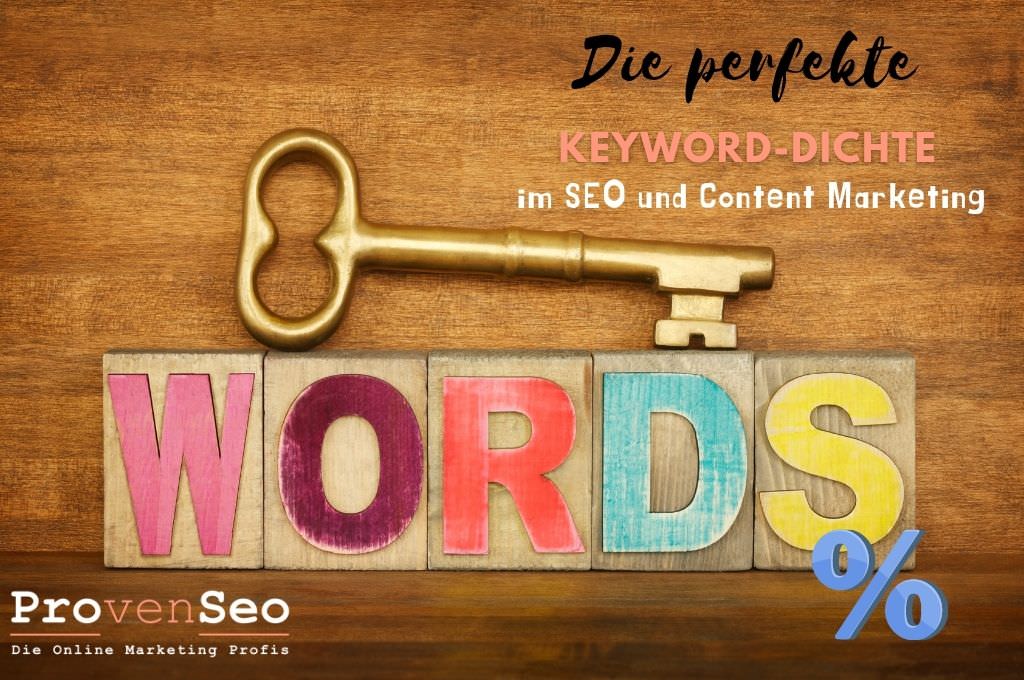Keyword-Dichte spielt bei der SEO 2022 immernoch eine große Rolle. Aber wie misst du die Dichte deiner Suchbegriffe und wie oft soll jeder Suchbegriff vorkommen? Für die Suchmaschinenoptimierung sind die Keywords (Dt. Schlüsselwörter) noch immer sehr wichtig, da sie Suchmaschinen und Lesern gleichermaßen mitteilen, was du mit deinem Text aussagen möchtest. Als Agentur für digitales Marketing beraten wir unsere Kunden eingehend zu ihren SEO- und Contentmarketing Strategien.
Dein Text muss Leser*innen UND Suchmaschinen gefallen
Natürlich ist es unmöglich, einen Inhalt zu erstellen, der alle Schlüsselwörter enthält, die deine Webseite verwenden möchte. Du musst deine Worte sorgfältig wählen, d.h. du musst Inhalte erstellen, die für Suchmaschinen optimiert sind, aber nicht so, dass sie wie ein Computerprogramm klingen. Hier kommt die Keyword-Dichte ins Spiel, die angibt, wie oft du ein Keyword in einer bestimmten Texteinheit verwendest. Doch wie wird die Keyword-Dichte im Content Marketing eigentlich errechnet?
Wie wird die Keyword-Dichte in Texten berechnet?
Das folgende Beispiel zeigt dir, wie du die Keyword-Dichte eines Artikels berechnen kannst. Du erfährst, wie du die Dichte eines Keywords in einem Satz und die Dichte eines ganzen Absatzes berechnen kannst. Außerdem hilft dir diese Anleitung, die Keyword-Dichte deines gesamten Inhalts zu berechnen. Der erste Schritt zur Berechnung der Keyword-Dichte besteht darin, deine Zielgruppe und dein Produkt zu definieren. Es ist dabei auch einfacher, zunächst den Namen deines Produktes (z.B. WordPress Webseitenerstellung) zu wählen. Du kannst im Netz nach Keyword Tools suchen, die dir Keyword Ideen liefern und mit denen du prüfen kannst, wie oft dein gewünschtes Keyword gesucht wird. Eventuell kannst du dadurch auch eine neue Keyword Idee generieren.
So berechnest du die Keyword-Dichte in deinen Texten
Die Keyword-Dichte wird ganz einfach berechnet, indem du das Keyword durch die Anzahl deiner Wörter teilst. Das kann pro Absatz oder pro ganzem Artikel geschehen. Schreibst du also einen Text über „WordPress Webdesign„, zählst du die Wörter deines Textes zusammen. Danach zählst du die Häufigkeit deines Keywords und dividierst diese Zahl durch die Gesamtzahl der Wörter.
Beispiel: Der Text hat 818 Wörter, das Keyword „WordPress Webdesign“ kommt 19x vor. Die Formel lautet: (19 / 818)* 100 = 2,32 %. Es handelt sich hierbei um eine Dreisatzberechnung. Du kannst auch andere Wege dazu nutzen, ganz wie dir beliebt.
Was solltest du beim Content in Bezug auf Keyword-Dichte vermeiden?
Dein Text muss in erster Linie einzigartig sein. Er sollte ein hohes Maß an Mehrwert für die Leser bieten. Und vor allem sollte die Keyword-Dichte deines Fokus-Schlüsselbegriffes nicht über 2,5% betragen. Aus meiner Sicht ist das der maximale Wert für die Keyword-Dichte. Du musst auch erkennen, dass dein Text weitaus mehr Keywords, also Suchbegriffe enthält als zunächst angenommen. So könnte beim o.g. Beispiel neben „WordPress Webdesign“ noch das Wort „Agentur“ dazu kommen. Google und andere Suchmaschinen erkennen heutzutage, aus welcher Sicht der Text geschrieben wird und mit welchem Inhalt er aufwartet.

Textlänge, Satzgefüge und Satzreihen mit Keywords
Auch wichtig ist die Länge der einzelnen Sätze. Satzgefüge bestehen aus mehreren Satzteilen (Hauptsatz, Nebensatz). Satzreihen hingegen sind kurz. Ein Text sollte eine harmonische Mischung aus beiden Satz-Arten ausmachen. So verteilen sich dann die Keywords besser und der Text wirkt lesbarer. Wenn in jeder zweiten Satzreihe ein Keyword steht, kann es mitunter fast lästig werden, weiterzulesen.
Über die Länge von Content streiten sich die SEO Geister. Die einen sagen, dass dein Text lang mit 1.000 Wörtern plus sein soll. Andere sagen, dass es nicht zwingend notwendig ist, zu schwafeln. Auch hier kann ich leider nur sagen, dass ein Mittelding aus beiden Strategien wohl das richtige ist. Schaue dir dein Thema an und bevor du nun ganze Passagen als Lückenfüller im Text beschreibst, solltest du lieber auf den Inhalt und dessen Qualität achten.
Long-Tail-Keyword-Strategien.
Wenn du also noch das Wort „Agentur“ zum „WordPress Webdesign“ zählst und du aus der „wir“ oder „ich“ Perspektive schreibst, kann der Leser und auch die Suchmaschine dein Unternehmen als Agentur für WordPress und Webdesign ableiten. Klingt logisch, oder? Ein kleiner weiterer Nebeneffekt dieser sogenannten ‚Long-Tail-Keywords‘ ist, dass er nicht nur das Grund-Keyword abdeckt, sondern auch gleich weitere und diese in direkten Bezug (WordPress+Agentur) setzt. Diese Art der Content-Strategie funktioniert aus meiner Sicht zum Beispiel hervorragend, um ein und dasselbe Theme auf einer Website in unterschiedlichen Beiträgen mit unterschiedlichen Schwerpunkten zu beäugen (z.B. ortsspezifisch werden mit WordPress+Agentur+Köln oder andere Städte)
Weniger (Keyword-Dichte) ist meist mehr
Auf eines solltest du er Text wirkt bei hoher Keyword-Dichte oftmals „robotermäßig“ überladen und das Lesen des Textes wird zu einer unschönen Herausforderung. Kurz: bei zu hoher Keyword Dichte verschwindet die ‚Message‘ deines Contents eher als dass sie zum Leser transportiert wird. Außerdem wirkt der Text dann sehr unbeholfen und niemand will ihn zu Ende lesen, geschweige denn bei Produkttexten das Produkt auch kaufen. Du musst also ein Gleichgewicht zwischen Keyword-Dichte und Text Message herstellen, sozusagen eine heterogene Verteilung deiner Wörter.
Fazit
Wenn du einen Text für deine Webseite, deinen Blog oder deinen e-Commerce Shop schreibst musst du auf genügend Content (ca. 600 – 1.000 Wörter) achten. Beschreibe dein Thema genau und vermeide lange Satzreihen. Du sollst auch nicht schwafeln und bestimmte Textpassagen nur der Lückenfüllung wegen schreiben. Sowohl Suchmaschinen als auch menschliche Leser*innen achten genau auf den Sinn eines Textes. Wenn ich nun einen Text beginne zu lesen und merke dann, es ist ein ellenlanger Erklärtext gebe ich auf. Genau wie Erklärvideos, solten solche Texte nicht zu lang und viel mehr abwechslungsreich geschrieben sein.
Übrigens: das Keyword „Keyword-Dichte“ erscheint in diesem Text 16 Mal, was ungefähr 1.8% Density (Dichte) ausmacht. 🙂









